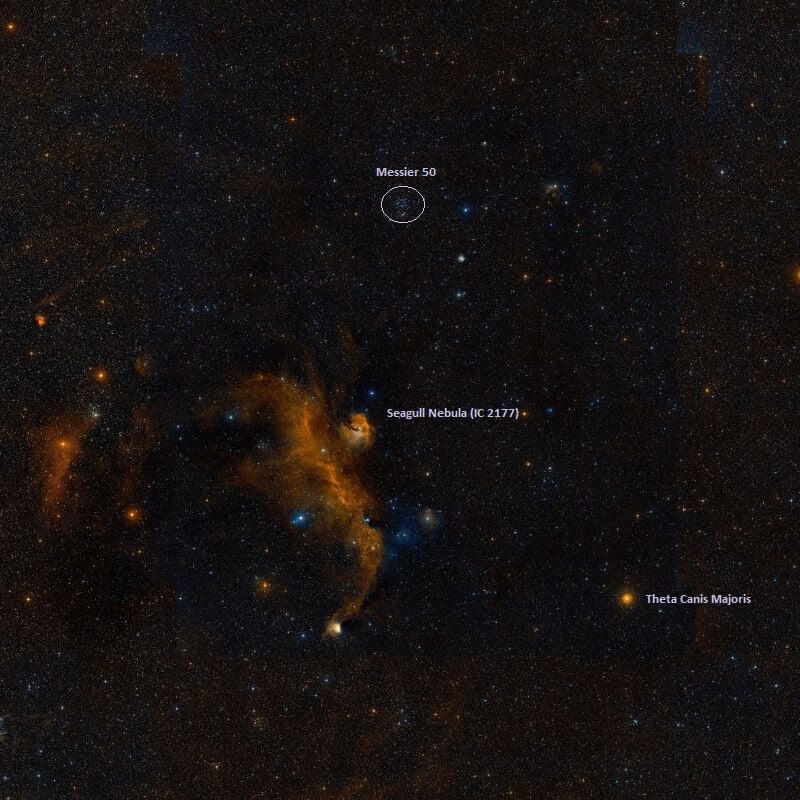Welcome back to Messier Monday! We continue our tribute to our dear friend, Tammy Plotner, by looking at the open star cluster of Messier 50. Enjoy!
In the 18th century, while searching the night sky for comets, French astronomer Charles Messier kept noting the presence of fixed, diffuse objects in the night sky. In time, he would come to compile a list of approximately 100 of these objects, with the purpose of making sure that astronomers did not mistake them for comets. However, this list – known as the
Messier Catalog
– would go on to serve a more important function.
One of these objects is the open star cluster known as Messier 50 (aka. NGC 2323). Located at a distance of about 3,200 light-years from Earth, this object sits near the border between the Monoceros and Canis Major constellations. It is described as a 'heart-shaped' figure, occupies an area about half the size of the full Moon, and is easy to find because of its proximity to Sirius (the brightest star in the night sky).
Description:
Located about 3,200 light years from our solar system, this stellar gathering could be perhaps as much as 20 light years across, but the central concentration is believed to only span across roughly 10 light years. While that doesn't seem that large, it's lit by the candlepower of what could be 200 stars! And picking such a group of stars out of a well-known OB1 association isn't easy. It requires photometry. As J.J. Claria (et al) remarked in a
1997 study
:
[caption id="attachment_136391" align="aligncenter" width="580"]
Close up of the Messier 50 open star cluster. Credit: Wikisky
[/caption]
In this region of the sky are vast molecular clouds compressing into star forming regions known as OB1 associations. The stars spawned by these vast clouds form into open clusters containing dozens to thousands of members and, over time, disassociate with not only the molecular cloud, but their sibling star clusters as well. Sure, it took 100-120 million years for it to happen, but as the group of stars cut away from the field, each member also aged differently.
By studying open clusters like M50 and its relative M35, we can learn more about the dynamics of star clusters which formed roughly at the same time in the same area. As Jasonjot Kalirai (et al) indicated in their
2003 study
:
So, did age or movement produce the colorful display of stars we can observe in M50 - or was it simply the chemical ingredients responsible? According to a
2005 study
conducted by Bragaglia and Monica:
[caption id="attachment_136392" align="aligncenter" width="580"]
The M50 open cluster. Credit: Ole Nielsen
[/caption]
History of Observation:
While M50 was possibly discovered by G.D. Cassini 1711, it was independently recovered by Charles Messier on the night of April 5th, 1772. In his notes, he wrote of his discovery:
It would later be observed by William Hershel, but not until his son John cataloged it before anyone began to notice colors in the stars. However, Admiral Smyth did!
Locating Messier 50:
Because M50 is such a big and bright open star cluster, it's relatively easy to find with complicated starhop instructions. Actually, the constellation of Monoceros is more difficult! Begin by identifying the brightest star in northern hemisphere skies - Alpha Canis Major - Sirius. Roughly a handspan to the northeast you'll see another prominent bright star - Alpha Canis Minor - Procyon.
[caption id="attachment_136390" align="aligncenter" width="580"]
The location of Messier 50 in the Monoceros constellation. Credit: IAU/Sky & Telescope magazine (Roger Sinnott & Rick Fienberg)
[/caption]
Between these two lay the faint and indistinguishable constellation of Monoceros, and slightly southwest of the center point is Messier 50. In small binoculars and a telescope finderscope, you'll quickly spot a compression in the starfield, and may even be able to see it as a slight contrast change with the unaided eye. In larger binoculars and small telescopes, it blooms into a cloud of stars, well resolved against the grainy backdrop of fainter stars.
In large aperture telescopes, even more stars resolve and colors begin to appear. Because of magnitude and the nature of star clusters, Messier 50 makes an outstanding target for high light pollution areas, moonlit nights and even less than perfect sky conditions.
Enjoy your own "colorful" observations of this rich and beautiful star cluster!
And as always, here are the quick facts on this Messier Object to help you get started:
- Object Name
-
Messier 50
- Alternative Designations
-
M50, NGC 2323
- Object Type
-
Open Galactic Star Cluster
- Constellation
-
Monoceros
- Right Ascension
-
07 : 03.2 (h:m)
- Declination
-
-08 : 20 (deg:m)
- Distance
-
3.2 (kly)
- Visual Brightness
-
5.9 (mag)
- Apparent Dimension
-
16.0 (arc min)
We have written many interesting articles about Messier Objects here at Universe Today. Here's Tammy Plotner's
Introduction to the Messier Objects
,
M1 – The Crab Nebula
, and David Dickison's articles on the
2013
and
2014
Messier Marathons.
Be to sure to check out our complete
Messier Catalog
. And for more information, check out the
SEDS Messier Database
.
Sources:
 Universe Today
Universe Today
